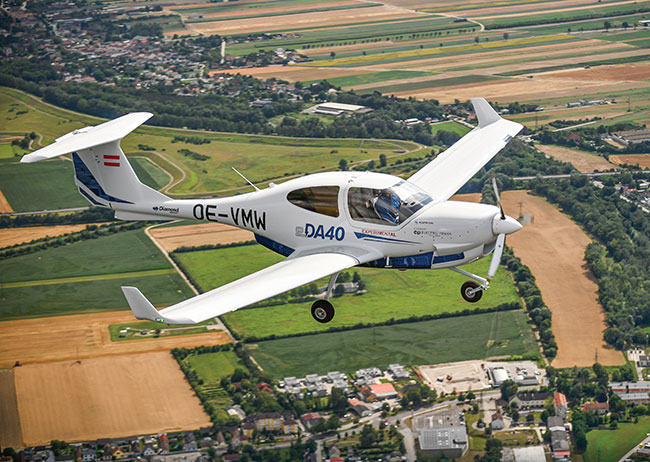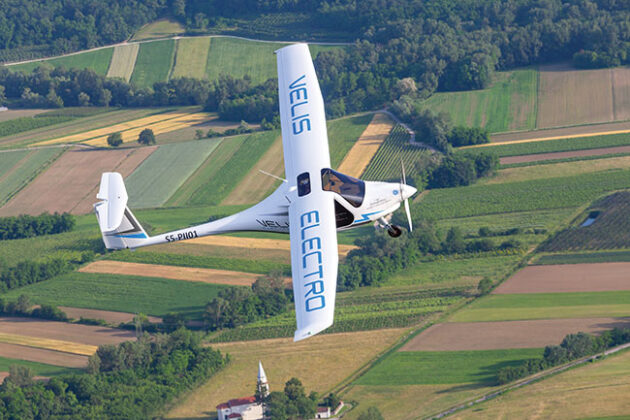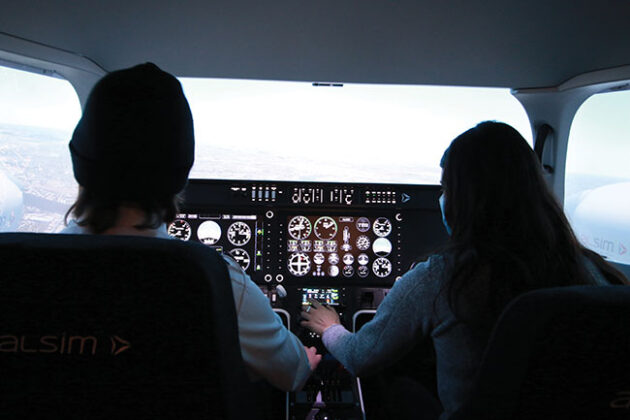
Features
Flight school economics
The challenges of training pilots in the current environment
February 7, 2024 By Phil Lightstone
 On 20 July 2023, the all-electric eDA40 made its first flight at Diamond Aircraft’s headquarters in Wiener Neustadt, Austria, a milestone achievement toward the certification of an aircraft that could significantly alter the plans of flight schools around the world.
(Photo: Diamond Aircraft)
On 20 July 2023, the all-electric eDA40 made its first flight at Diamond Aircraft’s headquarters in Wiener Neustadt, Austria, a milestone achievement toward the certification of an aircraft that could significantly alter the plans of flight schools around the world.
(Photo: Diamond Aircraft) Flight Training Units are the linch pin creating and growing aviation in Canada. Whether flying within general, business or commercial aviation, or any sector of the industry, pilots all start off in the same place, in the left seat of a Cessna 152/172 or a Diamond DA40 aircraft. Flight Training Units (FTUs) like Sault College have standardized on Zlins while Seneca College has a fleet of Cessna and Beechcraft aircraft.
Canadian Flight Training Units face many challenges, least of all winter. Many Ontario FTUs report that owning and operating a flight school has its own unique set of challenges (as compared to other aviation enterprises). All of the FTUs interviewed for this article stated, that under the current market conditions, with demand for flight training services exceeding supply, their operations are profitable. Most organizations declined (for obvious reasons) to quantify their profitability. A common observation was the need to scale their operations to generate a meaningful Return on Investment (ROI).
Primary impediments to profitability fall into two buckets: The weather; and commercial operators and airlines recruiting flight instructors from the FTUs. In Ontario, the average flyable days for flight schools over the past five years was 160 days. No surprise there. However, those flyable days contain many half days. Clearly the financial burden which the FTUs face is the amortization of fixed costs over a limited number of revenue generating days. Fixed costs such as rent, aircraft leases, administrative salaries, aircraft maintenance activities, professional services, to name a few, remain static as compared to the somewhat variable revenue sources. Flyable days can be offset to some degree through the utilization of certified simulators. Based upon the current profitability levels, one would argue that operating in a weather environment whereby the number of flyable days is increased to 90 per cent, would generate an attractive ROI.
The second constraining factors relates to the quantity and quality of flight instructors. With Category Four and Category Three instructors being siphoned from FTUs to the commercial operators, FTUs are seeing one to one and half years of revenue from their investment into flight instructors. Some larger FTUs are burdening their profitability with Human Resources salaries, recruitment activities, onboarding and training costs. Interestingly, during economic times of prosperity, with consumer disposable income on the rise, the airline industry increases its recruitment activities with a twofold outcome: Young people are attracted to the aviation industry (increasing demand); and the airlines recruit instructor pilots from the FTUs (reducing supply). During times of economic downturns, the airlines will furlough pilots, increase the supply of instructors, but reducing the demand for FTU capacity. The past decade has seen either a feast or famine with no happy equilibrium.

The two-seater Pipistrel Velis Electro, intended primarily for pilot training, became the world’s first electric powered airplane to receive a type certificate. (Photo: Textron Aviation)
An outcome of the COVID-19 pandemic is the rise in cost for typical training aircraft. Used Cessna 172s have seen a triple to quadruple increase in retail prices, while a brand new C172 has a two-year delivery time line. Canadian Flyers, now located at the Lindsay/Kawartha Lakes Municipal Airport (CNF4), manages its aircraft costs through standardizing on Cessna 172Ms. While flying older aircraft (vintage 1970s), the reliability of the airframe and the ability to swap components between aircraft, allows the utilization rates of its fleet to be improved. However, aircraft accidents and incidents may cause aircraft to be prematurely taken off-line either for repairs or replacement. Canadians Flyers had several incidents, including a York Regional Police RPAS (drone) colliding with its C172 (on final to runway 15 at CYKZ). Repairs to the aircraft were costly, but the impact to lost revenue was much greater. With a reduction in the fleet, the cost of goodwill both on a staff and customer level is immeasurable.
The Brampton Flight Centre (BFC) reports that the cost of fuel represents roughly 35 per cent of the aircraft’s hourly rental rate. BFC is unique in the Canadian FTU environment in that it owns the airport, lands, buildings, restaurant, aircraft and FTU with no debt. As such, its fuel is purchased on a wholesale level, whereas other FTUs purchase fuel from the local FBO (which has profit embedded in the price per litre). BFC employees roughly 90 people of which 35 are directly related to the FTU. With 400 students, 22 aircraft, two simulators, and 33 instructors, the FTU contributes to the financial health of the airport. One might speculate that without the financial contributions of the FTU, the value of the land could force the sale and closure of the airport (not that different to the closure of the Toronto Buttonville Municipal Airport, CYKZ). However, the airport is operated as a not-for-profit organization, with any surpluses reinvested into the airport.
Risks to profitability within the FTU sector include hobbyists starting small flight schools employing one to three flight instructors. This impacts the quantity of Class One and Class Two instructors which can be used in larger operations to create new flight instructors. Without the experience and a day-to-day focus on flight school operations, valuable resources are siphoned off, with a dubious return on investment. Weather is a risk to both the total number of flyable days, but also weather events (micro bursts, hail, thunderstorms, forest fires and flooding), which can damage aircraft.

Sault College`s Aviation Technology – Flight program is designed to prepare students for a career as a professional pilot, with Zlin and Piper planes supported by advanced flight simulators. (Photo: Sault College)
The University of Waterloo’s (UofW) aviation degree program, with flight training delivered by the Waterloo Wellington Flight Centre (WWFC), has 300 students enrolled over the four year course with 120 students admitted this year. With more than 600 student applicants (for 60 spots), many young people had to look to other colleges/universities and private flight training programs to fulfill their dreams. The flight training component of UofW’s aviation program is 100 per cent funded by the student. The academic portion of the aviation program is currently funding one third by the Ontario government (other provinces on average fund 57 per cent).
On the horizon waits the revolution of electric aircraft and its transition into the FTU. Current e-aircraft such as Diamond’s eDA40 and Pipistrel Velis Electro are flying in Europe with the Velis flying in Canada. The Velis has a maximum: cruise of 98 kcas; altitude of 12,000 feet; range of 50 minutes; and useful load of 378 pounds. The UofW in collaboration with WWFC and Transport Canada (TC) have been flying a Velis since June 2023 (the aircraft arrived in October 2022), gathering data for both TC’s certification requirements and the economic modeling of e-aircraft in the Canadian context. Dr. Paul Parke reports: “I’m an optimist viewing the move to e-aircraft as a simpler, cleaner and lower cost alternative to Internal Combustion Engines.”
While battery longevity and cost of replacement have not been validated in the field, from an economics perspective, the potential future cost of battery replacement should be expected to be lower than overhauling a combustion engine every 2,000 to 3,000 hours. A typical flight school could easily put 500 to 1,000 hours on an aircraft annually. With pandemic induced inflation, the cost of Internal Combustion Engines overhauls has increased substantially. In a perfect world, where the airport has three phase power, the marginal cost of electrification infrastructure plus the cost of electricity is expected to be considerably lower than 100LL avgas. Fossil fuel costs will be further increased based upon the federal government‘s (both U.S. and Canada) mandate to eliminate lead from avgas. Ongoing research and development into revolutionary battery technology is expected to increase the energy to weight ratios, reducing weight, increasing battery charge cycles while reducing costs. The aviation sector will be able to leverage the investments made by the automotive sector. The net result will be an improvement to profitability and, over time (based upon the transition to e-aircraft), an improvement in ROI.
The American trend of airlines owning flight schools has migrated north of the border with Chorus Aviation, Jazz, CAE creating Cygnet Aviation Academy in Kingston, Ontario. The program (announced May 28, 2023) is designed to deliver students an integrated airline pilot license program, which takes 18 months to complete.
“Cygnet and CAE will combine high-technology and leading-edge digital education and training to prepare direct-entry-ready First Officers for Canadian airlines,” says Lynne McMullen, President, Cygnet Aviation. “We’re excited to collaborate with Transport Canada to deliver a competency-based training model in support of cutting-edge programs for the next generation of aviation professionals. The launch of Cygnet establishes an organization dedicated to developing airline-ready First Officers from start to finish, using state of the art Diamond Aircraft and flight simulation training devices.” Course fees for the program is $126,000 (plus HST, housing, remedial training, headset, uniforms, computers and books). Jazz will onboard commercial pilots with 500 hours at a First Officer base pay of $64,300 (plus a daily tax-free meal per diem on average of $9,000 per month).
In the Canadian context, there are 280 accredited FTUs with management dealing with a variety of daily challenges. Top of mind is flight instructor recruitment and retention. Demand has been increasing year over year both from international and domestic students. The consensus within the FTUs interviewed for this article is, that in a perfect world (weather, aircraft availability and flight instructors), the FTU industry could easily accommodate double the number of students. Many, if not all, of FTU management are looking at solutions, strategies and tactics that will help narrow the gap between supply and demand. Only time will tell us about the ongoing trajectory of the Canadian FTU industry.